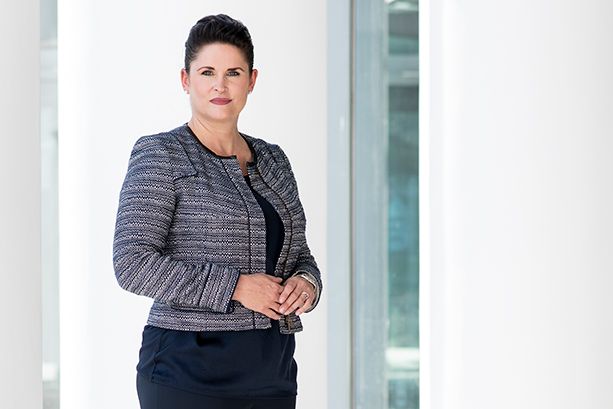
Julia Ries, Head of ERGO Art & Values ©ERGO
Julia Ries: "Basically, one should follow one's own passion in collecting, take advantage of opportunities to get to know art of different directions, and inform oneself."
According to the Global Art Market Report 2022, just released by UBS and Art Basel, the international art market recovered significantly in 2021 after having its sharpest sales decline in the last 10 years in 2020. Total sales of art by dealers and auction houses were estimated at $65.1 billion, a 29% increase in sales over 2020.
The art market is undergoing a lot of change and so the question is how key players, such as art insurance companies, view this. Alethea & Art Magazine received an interview from Julia Ries, Head of ERGO Art & Values.
From people buying their first piece of art to art collectors, they all buy for very different reasons - passion, prestige or investment considerations. For them, the question is how to protect their treasures or investments.
What role does Environment Social Governance or sustainability play for museums, galleries and auction houses in 2022 and is the loan of artworks still tolerable?
Moving on to Art Innovation NFT: Can these be insured at all because of cyber risks and have NFT's also led to innovations in insurance products?
April 6, 2022
Interview Directory
ART
Name: Julia Ries
Occupation: Head of ERGO Art & Values
Dream job: "It's a dream job that combines the rather dry subject of insurance with the multifaceted world of art."
What is the particular challenge of art insurance and how difficult is it to determine the value of artworks? Who is involved in the valuation of a work of art?
The insurance of art objects requires the agreement of the sum insured. This is essentially based on the fair market value of art objects, which is determined by art historians, among others. These experts examine the objects to be insured and consult databases, for example, to compare current market developments. This service is offered in the risk assessment of collections by insurance companies. For the insurance of galleries, on the other hand, the declared sales price or the commission value is used as the insured value. For works from museums, we refer to the assessment of the in-house experts of the respective institution and agree on fixed valuations.
Who are your main clients - private collectors, museums or galleries?
We have all customer groups in mind: In addition to private collectors, these include corporate collections, foundations, the art trade, such as galleries and auction houses, and institutional clients, such as museums with their collections and exhibition operations. Art transportation and art storage round out the target group focus.
"Collectors have very different motives for collecting - be it out of passion, prestige or investment considerations. "
What is the profile of a collector who has his art collection insured?
Collectors have very different motives for collecting - be it out of passion, prestige or investment considerations. The need to insure valuable works of art is usually based on the desire to preserve the work of art for oneself personally as well as for posterity and to protect oneself financially in the best possible way against losses in value, e.g. as a result of damage. In particular, to take into account the increasing value of collection objects. Reductions in value as a result of damage can be considerable. Art insurance tailored to the special requirements of art objects is the optimal choice here.
"Large blockbuster exhibitions with international loans will not disappear in the future."
How has the market for works of art developed over the past 10 years, and can you give any forecasts?
The art market has grown at an average annual rate of 14% over the past decade, but has also had sharp declines and shifts in the last two years as a result of the pandemic, particularly with the elimination of many art fairs and exhibitions. The share of online sales, on the other hand, has risen sharply over the same period.
We expect digitization to continue to advance. However, this trend will not replace the existing market or institutions. Reception in front of the original, for example, still plays a major role. Here, digital exhibition spaces can only be a supplement in mediation. Large blockbuster exhibitions with international loans will not disappear in the future. However, it could be that museums will increasingly stage exhibitions from their own holdings, as trends such as ESG (Environment Social Governance) or sustainability are also likely to play a role in the art market with regard to loan traffic and the transport of art objects.
"The use of blockchains can already be observed for a few years in the art world, for example in collection management apps."
Are there any innovations in the field of art insurance? How are NFTs actually insured?
As in art itself, there are innovations in the insurance of art. Customer demands in connection with hybrid consumer behavior have also led to more innovative products in the insurance industry with online conclusion options. These enable leaner work processes, including through dark processing and automated policy creation.
The use of blockchains can already be observed for a few years in the art world, for example in collection management apps. For NFTs, which have been the talk of the town since last year due to the Beeple auction, there are already several schools of thought in the market on how to insure these digital artworks. Here, however, the means of art insurance as pure property insurance are far from sufficient. Cyber risks play a greater role here.
Alethea & Art Magazine: What would you advise a prospective collector - how should they proceed if they want to start a collection?
Depending on the individual motive for collecting, one should orient oneself to art objects that are in line with this. These can be very different motifs. Basically, one should follow one's own passion in collecting, take advantage of opportunities to get to know art of different directions, and inform oneself.
Does the Cultural Property Protection Act play a role in your field?
The Cultural Property Protection Act is only of limited and rather indirect significance in the insurance business. When the new law was announced and came into force, there was initially a great deal of uncertainty among collectors and in the art trade. As a result, there were increasing inquiries about the provision of additional insurance capacity for art storage facilities. At present, the issue plays only a secondary role, especially since the usual market conditions do not generally include insurance for confiscation and intervention by public authorities.
Nevertheless, the issue of the provenance of art objects is relevant in underwriting. Art insurers are also directly affected when art is placed on the market, for example, when a total loss claim is processed and ownership is transferred to the insurer.
Some personal questions: How did your path to art begin?
As a schoolgirl, I liked to go on pilgrimages to museums, wanting to become either a surgeon or a gallery owner. My profession then became economics, which opened the door to the insurance industry for me. For many years, I have been involved in the development of coverage concepts for art and luxury goods in an international environment. It's a dream job that combines the rather dry subject of insurance with the multifaceted world of art.
Which art movements do you personally like and do you have a favorite painter?
All art epochs appeal to me, as they are always a reflection of society and the respective time. Not everything has to please, but it should always arouse emotions, occasionally overwhelm or make you think.
TOP STORIES
CHECK THE THINGS YOU WANT TO THROW AWAY
HA Schult's Trash People at the Circular Valley Forum in Wuppertal on 18 November 2022.
NOVEMBER 19, 2022
_____________________
THE OPERA OF THE FUTURE
Düsseldorf, capital of North Rhine-Westphalia will receive the opera house of the future.
FEBRUARY 15, 2023
_____________________
LONDON
Opening: Lightroom, London's new artist home, shows: David Hockney
DECEMBER 2, 2022
_____________________
FLORENCE
The extraordinary museums of Florence in 2023.
JANUARY 1, 2023
____________________
DÜSSELDORF
DECEMBER 11, 2022
____________________
IN BEAUTIFUL A CORUNA
New exhibition of the Marta Ortega Pérez Foundation: "Steven Meisel 1993" .
DECEMBER 5, 2022
____________________
WORLDLEADER
How did ProWein manage to become No. 1 in contrast to other international trade fairs.
MARCH 15, 2023
____________________
INTERNATIONAL TOGETHERNESS
MARCH 8, 2023
____________________
TRAVEL
What major events in art, culture and society are we facing?
JANUARY 21, 2023
____________________
Hollywood
____________________
DISTANT WORLDS
Dieter Nuhr's paintings now in Senegal - "A Nomad in Eternal Transit"
DECEMBER 6, 2022
RELATED TALKS






